Saturn I
| |
Mimas averages 396 kilometers (246 miles) in diameter. Shock waves from the Herschel impact may have caused the fractures, also called chasmata, on the opposite side of Mimas. Mimas is not quite big enough to hold a round shape; the shape is somewhat ovoid with dimensions of 209 x 196 x 191 kilometers (130 x 122 x 119 miles, respectively). Mimas orbits at a range of 185,520 kilometers (115,280 miles) from Saturn in a time of 22 hours and 37 minutes. This orbit makes Mimas the closest major moon of Saturn. Mimas is tidally locked to Saturn with one side always facing in toward its parent. Mimas' close orbit means that Mimas probably receives several times the rate of collisions as the other moons of Saturn.
Mimas and another Saturn moon, Rhea, have been called "the most heavily cratered body in the Solar System." Mimas would probably have been more heavily cratered except, being closer to Saturn, Mimas was warmer (and consequently softer) for a longer time so early features have faded away. However, with so many impacts the youngest craters have tended to obliterate the older ones, and these moons are cratered about as much as they can get.
Most of the Mimas surface is saturated with impact craters ranging in size up to greater than 40 kilometers (25 miles) in diameter, although none are anywhere near the size of Herschel. However, the craters in the South Pole region of Mimas are generally 20 kilometers (12.4 miles) in diameter or less. This suggests that some melting or other resurfacing processes occurred there later than on the rest of the moon. (Interestingly, the South Pole area of Enceladus appears to be the source of that moon's geysers.)
Mimas' low density (1.17 times the density of liquid water) indicates that it is composed mostly of water ice with only a small amount of rock. It seems to be solidly frozen at a temperature of 209 degrees Celsius (-344 degrees Fahrenheit). This is puzzling because Mimas is closer to Saturn than Enceladus, and the Mimantean orbit is much more eccentric (out of round) than the Enceladean orbit. Thus, Mimas should have much more tidal heating than Enceladus. Yet, Enceladus has geysers of water, while Mimas has one of the most heavily cratered surfaces in the Solar System. This suggests a frozen Mimas surface that has persisted for a very long time. This paradox has led astronomers to use the "Mimas test" by which a theory to explain the partially thawed water of Enceladus must also explain the entirely frozen water of Mimas.
Mimas apparently cleared enough material to create the 4,800-kilometer (2,980-mile) wide gap (called the Cassini Division) between Saturn's two widest rings, the A and B rings. Observations from Cassini revealed that there is still some ring material in the Cassini Division, although it is sparse enough that the area appears dark from a distance.
Mimas is in resonance with two nearby moons, Dione and Enceladus. That is, these moons speed up slightly as they approach each other and slow down as they draw away, causing their orbits to vary slightly in a long series of complex changes, which help keep them locked in their positions.
Mimas strongly perturbs the tiny 3-kilometer (2-mile) diameter moon Methone, the 4-kilometer (3-mile) diameter moon Pallene, and the 2-kilometer (1-mile) diameter moon Anthe, all of which orbit between Mimas and the next major moon going out from Saturn, Enceladus. The vastly more massive Mimas causes the Methone orbit to vary by as much as 20 kilometers (12.4 miles). The perturbations are larger for tiny Anthe, and slightly smaller for Pallene.
Discovery
Ground-based astronomers could only see Mimas as little more than a dot until Voyagers I and II imaged it in 1980. The Cassini spacecraft has made several close approaches and provided detailed images of Mimas since Cassini achieved orbit around Saturn in 2004.
William [Friederick Wilhelm] Herschel discovered Mimas in 1789. His son, John Herschel suggested that the moons of Saturn be associated with Greek mythical brothers and sisters of Kronus, known to the Romans as Saturn.
The name Mimas comes from the god (or Titan) Mimas in Greek mythology who was slain by one of the gods of Olympus in the war between the Olympians and the titans. Different accounts have Mimas dispatched by Hercules, by Ares (the god of war), or by Zeus himself using a thunderbolt. Legend has it that the island of Prochyte near Sicily rests on his body.
Astronomers also refer to Mimas as Saturn I based on its distance being the closest to Saturn. The International Astronomical Union now controls the official naming of astronomical bodies.
| Mimas Statistics | |
|---|---|
| Discovered by | William Herschel |
| Date of discovery | 1789 |
| Mass (kg) | 3.80e+19 |
| Mass (Earth = 1) | 6.3588e-06 |
| Equatorial radius (km) | 196 |
| Equatorial radius (Earth = 1) | 3.0731e-02 |
| Mean density (gm/cm^3) | 1.17 |
| Mean distance from Saturn (km) | 185,520 |
| Rotational period (days) | 0.942422 |
| Orbital period (days) | 0.942422 |
| Mean orbital velocity (km/sec) | 14.32 |
| Orbital eccentricity | 0.0202 |
| Orbital inclination (degrees) | 1.53 |
| Escape velocity (km/sec) | 0.161 |
| Visual geometric albedo | 0.5 |
| Magnitude (Vo) | 12.9 |
| Mean surface temperature | -200°C |
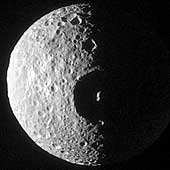 Herschel: Dead-On
Herschel: Dead-On
Saturn's moon Mimas has many large craters, but its Herschel crater dwarfs all the rest. This large crater 130 kilometers wide (80 miles) has a prominent central peak, seen here almost exactly on the terminator. This crater is the moon's most prominent feature, and the impact that formed it probably nearly destroyed Mimas. Mimas is 398 kilometers (247 miles) across.
This view is predominantly of the leading hemisphere of Mimas. The image has been rotated so that north on Mimas is up. (Courtesy NASA/JPL/Space Science Institute)
 Mimas Showing False Colors
Mimas Showing False Colors
False color images of Saturn's moon, Mimas, reveal variation in either the composition or texture across its surface.
During its approach to Mimas on Aug. 2, 2005, the Cassini spacecraft narrow-angle camera obtained multi-spectral views of the moon from a range of 228,000 kilometers (142,500 miles).
The image at the left is a narrow angle clear-filter image, which was separately processed to enhance the contrast in brightness and sharpness of visible features. The image at the right is a color composite of narrow-angle ultraviolet, green, infrared and clear filter images, which have been specially processed to accentuate subtle changes in the spectral properties of Mimas' surface materials. To create this view, three color images (ultraviolet, green and infrared) were combined into a single black and white picture that isolates and maps regional color differences. This "color map" was then superimposed over the clear-filter image at the left.
The combination of color map and brightness image shows how the color differences across the Mimas surface materials are tied to geological features. Shades of blue and violet in the image at the right are used to identify surface materials that are bluer in color and have a weaker infrared brightness than average Mimas materials, which are represented by green.
Herschel crater, a 140-kilometer-wide (88-mile) impact feature with a prominent central peak, is visible in the upper right of each image. The unusual bluer materials are seen to broadly surround Herschel crater. However, the bluer material is not uniformly distributed in and around the crater. Instead, it appears to be concentrated on the outside of the crater and more to the west than to the north or south. The origin of the color differences is not yet understood. It may represent ejecta material that was excavated from inside Mimas when the Herschel impact occurred. The bluer color of these materials may be caused by subtle differences in the surface composition or the sizes of grains making up the icy soil. (Courtesy NASA/JPL/Space Science Institute)
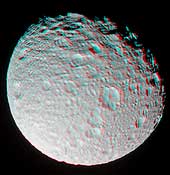 Mimas in 3D
Mimas in 3D
This 3D picture of Saturn's moon Mimas, shows it to be one of the most heavily cratered Saturnian moons, with little if any evidence for internal activity. Mimas has been so heavily cratered that new impacts can only overprint or even completely obliterate other older craters. Mimas is 397 kilometers or (247 miles) across.
The moon displays an unexpected array of crater shapes. The highest crater walls tower 6 kilometers (4 miles) above the floors and show signs of material sliding down slope. Indeed, many of the large craters -- more than 15 kilometers (10 miles) in diameter -- appear to be filled in with rough-surfaced material, likely the result of landslides triggered by subsequent impacts elsewhere on Mimas' surface. Some of these deposits have craters superimposed on them, demonstrating that the landslides themselves may be quite old.
Grooves, some of which are over a kilometer deep, cut across the surface for more than 100 kilometers (63 miles). These are some of the only indications that there might have once been internal activity under this ancient, battered surface. (Copyright Calvin J. Hamilton)
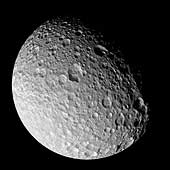 A World of Hurt
A World of Hurt
The most detailed images ever taken of Saturn's moon Mimas show it to be one of the most heavily cratered Saturnian moons, with little if any evidence for internal activity. Mimas has been so heavily cratered that new impacts can only overprint or even completely obliterate other older craters. Mimas is 397 kilometers or (247 miles) across.
The moon displays an unexpected array of crater shapes. The highest crater walls tower 6 kilometers (4 miles) above the floors and show signs of material sliding down slope. Indeed, many of the large craters -- more than 15 kilometers (10 miles) in diameter -- appear to be filled in with rough-surfaced material, likely the result of landslides triggered by subsequent impacts elsewhere on Mimas' surface. Some of these deposits have craters superimposed on them, demonstrating that the landslides themselves may be quite old.
Grooves, some of which are over a kilometer deep, cut across the surface for more than 100 kilometers (63 miles). These are some of the only indications that there might have once been internal activity under this ancient, battered surface. (Courtesy NASA/JPL/Space Science Institute)
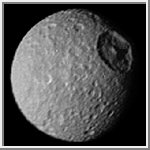 Mimas & Herschel Crater
Mimas & Herschel Crater
This image of Mimas was acquired by the Voyager 1 spacecraft on November 11, 1980 from a range of 425,000 kilometers (264,000 miles). The large crater on the right limb is named Herschel. It is 130 kilometers (80 miles) wide and one-third the diameter of Mimas. Herschel is 10 kilometers (6 miles) deep, with a central mountain almost as high as Mount Everest on Earth. This impact probably came close to disintegrating the moon. (Copyright Calvin J. Hamilton)
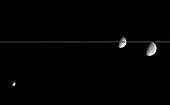 Amazing Icy Moons
Amazing Icy Moons
A scene straight out of science fiction, this fantastic view shows, from left to right, Saturn's moon's Mimas, Dione and Rhea, on the far side of Saturn's nearly edge-on rings.
The trailing hemispheres of all three moons are sunlit here, and wispy markings can be seen on the limbs of both Dione and Rhea. The diameter of Mimas is 397 kilometers (247 miles), Dione is 1,118 kilometers (695 miles) and Rhea is 1,528 kilometers (949 miles). (Courtesy NASA/JPL/Space Science Institute)
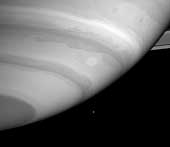 Dwarfed by Storms
Dwarfed by Storms
Tiny Mimas is dwarfed by a huge white storm and dark waves on the edge of a cloud band in Saturn's atmosphere.
Although the east-west winds on Saturn are stronger than on Earth or even Jupiter, the contrast in appearance between these zones is more muted, and the departures of the wind speeds from east to west are lower.
The image was taken with the Cassini spacecraft narrow angle camera on Sept. 25, 2004, at a distance of 7.8 million kilometers (4.8 million miles) from Saturn through a filter sensitive to wavelengths of infrared light centered at 727 nanometers. The image scale is 46 kilometers (29 miles) per pixel. (Courtesy NASA/JPL/Space Science Institute)
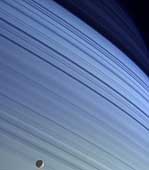 Mimas Blues
Mimas Blues
Mimas drifts along in its orbit against the azure backdrop of Saturn's northern latitudes in this true color view. The long, dark lines on the atmosphere are shadows cast by the planet's rings.
Saturn's northern hemisphere is presently relatively cloud-free, and rays of sunlight take a long path through the atmosphere. This results in sunlight being scattered at shorter (bluer) wavelengths, thus giving the northernmost latitudes their bluish appearance at visible wavelengths.
At the bottom, craters on icy Mimas (398 kilometers, or 247 miles across) give the moon a dimpled appearance.
Images taken using infrared (930 nanometers), green (568 nanometers) and ultraviolet (338 nanometers) spectral filters were combined. The colors have been adjusted to match closely what the scene would look like in natural color. See PIA06142 for a similar view in natural color.
The images were obtained using the Cassini spacecraft narrow angle camera on Jan. 18, 2005, at a distance of approximately 1.4 million kilometers (870,000 miles) from Saturn. Resolution in the image is 8.5 kilometers (5.3 miles) per pixel on Saturn and 7.5 kilometers (4.7 miles) per pixel on Mimas. The image has been contrast-enhanced to aid visibility. (Courtesy NASA/JPL/Space Science Institute)
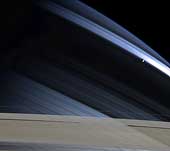 Nature's Canvas
Nature's Canvas
In a splendid portrait created by light and gravity, Saturn's lonely moon Mimas is seen against the cool, blue-streaked backdrop of Saturn's northern hemisphere. Delicate shadows cast by the rings arc gracefully across the planet, fading into darkness on Saturn's night side.
The part of the atmosphere seen here appears darker and more bluish than the warm brown and gold hues seen in Cassini images of the southern hemisphere, due to preferential scattering of blue wavelengths by the cloud-free upper atmosphere.
The bright blue swath near Mimas (398 kilometers, or 247 miles across) is created by sunlight passing through the Cassini division (4,800 kilometers, or 2,980 miles wide). The rightmost part of this distinctive feature is slightly overexposed and therefore bright white in this image. Shadows of several thin ringlets within the division can be seen here as well. The dark band that stretches across the center of the image is the shadow of Saturn's B ring, the densest of the main rings. Part of the actual Cassini division appears at the bottom, along with the A ring and the narrow, outer F ring. The A ring is transparent enough that, from this viewing angle, the atmosphere and threadlike shadows cast by the inner C ring are visible through it. (Courtesy NASA/JPL/Space Science Institute)
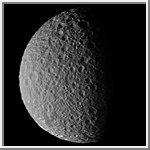 Mimas
Mimas
This image of Mimas was acquired by the Voyager 1 spacecraft on November 13, 1980. Traces of fracture marks, probably due to the Herschel Impact, can be seen on this side of Mimas. (Copyright Calvin J. Hamilton)
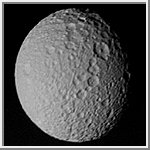 Mimas
Mimas
This is another image of Mimas acquired by the Voyager 1 spacecraft on November 13, 1980. The surface is heavily cratered indicating an ancient surface age. (Copyright Calvin J. Hamilton)
0 comments:
Post a Comment